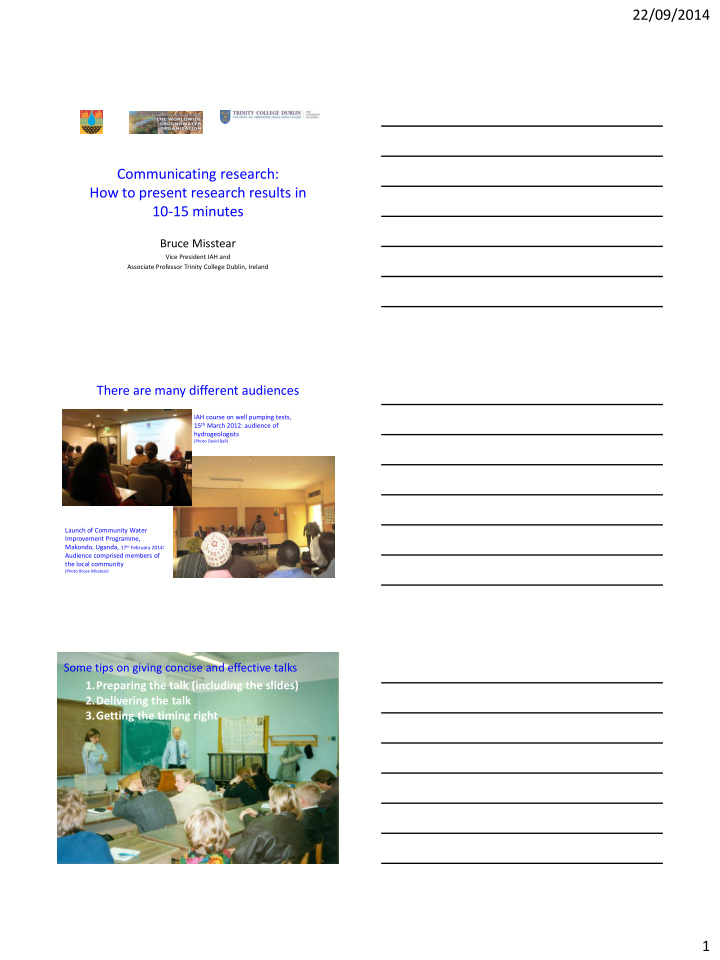



22/09/2014 Communicating research: How to present research results in 10-15 minutes Bruce Misstear Vice President IAH and Associate Professor Trinity College Dublin, Ireland There are many different audiences IAH course on well pumping tests, 15 th March 2012: audience of hydrogeologists (Photo David Ball) Launch of Community Water Improvement Programme, Makondo, Uganda, 17 th February 2014 : Audience comprised members of the local community (Photo Bruce Misstear) Some tips on giving concise and effective talks 1.Preparing the talk (including the slides) 2.Delivering the talk 3.Getting the timing right 1
22/09/2014 Preparing the talk (including the slides) • First: ask yourself: what does the audience want from your presentation? – What aspects of your research are the audience likely to be interested in? • An audience will only remember 3 or 4 points from your talk, so you need to make these clear • When making a significant point, make it memorable by including a striking image • Do not put too much text on slides • Illustrations should be simple and attractive • Do not put your Acknowledgments as your last slide – better to include them earlier and then leave your Conclusions slide up on the screen when you finish The version on the left has too much detail for a presentation (Turk & Kirkman, 1989) 2
22/09/2014 World scaled according to public health spending (2006) http://www.worldmapper.org/index.html Including an extract of this chart helps communicate the message that an earthquake in far away Indonesia can affect groundwater levels in Ireland 2012 Graphs should be simple This graph shows calculated screen upflow head losses (calculated using Manning-type formula; 24 m slotted pipe) (Misstear, 2012) 3
22/09/2014 Economic optimisation of well design (in extensive uniform aquifers) Applying a simple equilibrium relationship for well design, and substituting screen length ( L s ) for aquifer thickness: 2 Q T KL s s w 2 Q s w KL s (Misstear, 2012) Economic optimisation of well design Minimum total cost Cost Operating costs (PV) Capital costs Screen length (m) (Misstear, 2012) Simple sketches can be effective (IAH Netherlands Chapter) 4
22/09/2014 (Thomsen et al., HJ, 2004) Photo: D. Daly Photo: B. Misstear Photo: D. Daly (Slide prepared by Jenny Deakin) www.wfdvisual.com Photo: Salmon Ireland 5
22/09/2014 Slide from my presentation on Thursday 8 mg/l NO3 as NO3 Mattock nutrient mixing model 0.14 Outlet Feb 2012 Quick flow Headwaters Feb 2012 37.5 mg/l NO3 as NO3 0.12 Overland flow Land drains Bedrock groundwater So, I don’t always follow my own advice! 0.1 Subsoil BHs Orthophosphate (mg/l P) Ditches Outlet Jun 2012 0.08 Headwaters Jun 2012 0.06 0.035 mg/l PO4 as P 0.04 0.02 0 0 1 2 3 4 5 6 7 8 9 10 11 Baseflow Nitrate (mg/l N) Sometimes a quotation can be effective in emphasising the importance of our work ‘More people die from unsafe water than from all forms of violence, including war.’ UN Secretary-General Ban Ki-moon, 22 nd March 2010 Delivering the talk • Do not read your presentation: – Reading the slides directly is very boring and takes a lot of time – Remember: the audience can read the slides much faster than you can say them out loud – Just use the slides (or a few notes on cards) as a guide to your talk, but try and be spontaneous • Be enthusiastic • Do not stand in front of the screen • Don’t mumble or speak in a monotone 6
22/09/2014 Getting the timing right • An audience will forgive you almost anything provided you finish on time • Don’t spend too long on your introduction, background and methodology • Make sure you leave enough time to cover your results and your conclusions • You can save time by saying e.g.: – “I don’t have time to discuss my sampling protocols in detail, but I would be happy to answer questions” By saying this, you are also engaging with the audience • Finally: practice! http://www.greenpowerconferences.com/home/downloads/Harvard-Business-Review_How-To-Give-a-Killer-Presentation.pdf 7
Recommend
More recommend